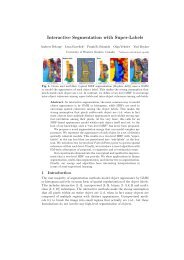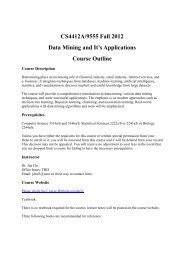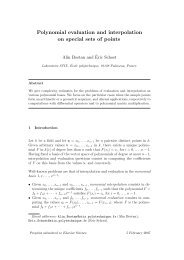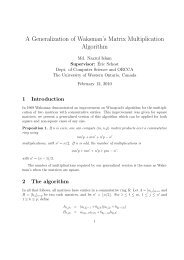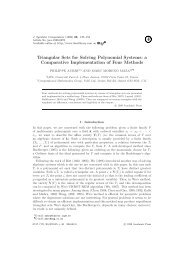Chapter 4 Threads, SMP, and Microkernels Microkernels
Chapter 4 Threads, SMP, and Microkernels Microkernels
Chapter 4 Threads, SMP, and Microkernels Microkernels
You also want an ePaper? Increase the reach of your titles
YUMPU automatically turns print PDFs into web optimized ePapers that Google loves.
Operating Systems:<br />
Internals <strong>and</strong> Design Principles, 6/E<br />
William Stallings<br />
<strong>Chapter</strong> 4<br />
<strong>Threads</strong>, <strong>SMP</strong>, <strong>and</strong><br />
<strong>Microkernels</strong><br />
Dave Bremer<br />
Otago Polytechnic, N.Z.<br />
©2008, Prentice Hall
Roadmap<br />
• <strong>Threads</strong>: Resource ownership <strong>and</strong><br />
execution<br />
• Symmetric multiprocessing (<strong>SMP</strong>).<br />
• Microkernel<br />
• Case Studies of threads <strong>and</strong> <strong>SMP</strong>:<br />
– Windows<br />
– Solaris<br />
– Linux
Processes <strong>and</strong> <strong>Threads</strong><br />
• Processes have two characteristics:<br />
– Resource ownership - process includes a<br />
virtual address space to hold the process<br />
image<br />
– Scheduling/execution - follows an execution<br />
path that may be interleaved with other<br />
processes<br />
• These two characteristics are treated<br />
independently by the operating system
Processes <strong>and</strong> <strong>Threads</strong><br />
• The unit of dispatching is referred to as a<br />
thread or lightweight process<br />
• The unit of resource ownership is referred<br />
to as a process or task
Multithreading<br />
• The ability of an<br />
OS to support<br />
multiple,<br />
concurrent paths<br />
of execution within<br />
a single process.
• MS-DOS supports a<br />
single user process<br />
<strong>and</strong> a single thread.<br />
Single Thread<br />
Approaches<br />
• Some UNIX, support<br />
• Some UNIX, support<br />
multiple user<br />
processes but only<br />
support one thread<br />
per process
Multithreading<br />
• Java run-time<br />
environment is a<br />
single process with<br />
multiple threads<br />
• Multiple processes<br />
<strong>and</strong> threads are found<br />
in Windows, Solaris,<br />
<strong>and</strong> many modern<br />
versions of UNIX
Processes<br />
• A virtual address space which holds the<br />
process image<br />
• Protected access to<br />
– Processors,<br />
– Other processes,<br />
– Files,<br />
– I/O resources
One or More <strong>Threads</strong> in<br />
• Each thread has<br />
Process<br />
– An execution state (running, ready, etc.)<br />
– Saved thread context when not running<br />
– An execution stack<br />
– Some per-thread static storage for local<br />
variables<br />
– Access to the memory <strong>and</strong> resources of its<br />
process (all threads of a process share this)
One view…<br />
• One way to view a thread is as an<br />
independent program counter operating<br />
within a process.
<strong>Threads</strong> vs. processes
Benefits of <strong>Threads</strong><br />
• Takes less time to create a new thread<br />
than a process<br />
• Less time to terminate a thread than a<br />
process<br />
• Switching between two threads takes less<br />
time that switching processes<br />
• <strong>Threads</strong> can communicate with each other<br />
– without invoking the kernel
Thread use in a<br />
Single-User System<br />
• Foreground <strong>and</strong> background work<br />
• Asynchronous processing<br />
• Speed of execution<br />
• Modular program structure
<strong>Threads</strong><br />
• Several actions that affect all of the<br />
threads in a process<br />
– The OS must manage these at the process<br />
level.<br />
• Examples:<br />
– Suspending a process involves suspending all<br />
threads of the process<br />
– Termination of a process, terminates all<br />
threads within the process
Activities similar<br />
to Processes<br />
• <strong>Threads</strong> have execution states <strong>and</strong> may<br />
synchronize with one another.<br />
– Similar to processes<br />
• We look at these two aspects of thread<br />
functionality in turn.<br />
– States<br />
– Synchronisation
Thread Execution States<br />
• States associated with a change in thread<br />
state<br />
– Spawn (another thread)<br />
– Block<br />
• Issue: will blocking a thread block other, or all,<br />
threads<br />
– Unblock<br />
– Finish (thread)<br />
• Deallocate register context <strong>and</strong> stacks
• Consider:<br />
Example:<br />
Remote Procedure Call<br />
– A program that performs two remote<br />
procedure calls (RPCs)<br />
– to two different hosts<br />
– to obtain a combined result.
RPC<br />
Using Single Thread
RPC Using<br />
One Thread per Server
Multithreading<br />
on a Uniprocessor
Adobe PageMaker
Categories of<br />
Thread Implementation<br />
• User Level Thread (ULT)<br />
• Kernel level Thread (KLT) also called:<br />
– kernel-supported threads<br />
– lightweight processes.
User-Level <strong>Threads</strong><br />
• All thread<br />
management is done<br />
by the application<br />
• The kernel is not<br />
• The kernel is not<br />
aware of the<br />
existence of threads
Relationships between ULT<br />
Thread <strong>and</strong> Process States
Kernel-Level <strong>Threads</strong><br />
• Kernel maintains context<br />
information for the<br />
process <strong>and</strong> the threads<br />
– No thread management<br />
done by application<br />
• Scheduling is done on a<br />
thread basis<br />
• Windows is an example<br />
of this approach
Advantages of KLT<br />
• The kernel can simultaneously schedule<br />
multiple threads from the same process on<br />
multiple processors.<br />
• If one thread in a process is blocked, the<br />
kernel can schedule another thread of the<br />
same process.<br />
• Kernel routines themselves can be<br />
multithreaded.
Disadvantage of KLT<br />
• The transfer of control from one thread to<br />
another within the same process requires<br />
a mode switch to the kernel
Combined Approaches<br />
• Thread creation done in<br />
the user space<br />
• Bulk of scheduling <strong>and</strong><br />
synchronization of<br />
threads by the<br />
application<br />
• Example is Solaris
Relationship Between<br />
Thread <strong>and</strong> Processes
Roadmap<br />
• <strong>Threads</strong>: Resource ownership <strong>and</strong><br />
execution<br />
• Symmetric multiprocessing (<strong>SMP</strong>).<br />
• Microkernel<br />
• Case Studies of threads <strong>and</strong> <strong>SMP</strong>:<br />
– Windows<br />
– Solaris<br />
– Linux
Traditional View<br />
• Traditionally, the computer has been<br />
viewed as a sequential machine.<br />
– A processor executes instructions one at a<br />
time in sequence<br />
– Each instruction is a sequence of operations<br />
• Two popular approaches to providing<br />
parallelism<br />
– Symmetric MultiProcessors (<strong>SMP</strong>s)<br />
– Clusters (ch 16)
Categories of<br />
Computer Systems<br />
• Single Instruction Single Data (SISD)<br />
stream<br />
– Single processor executes a single instruction<br />
stream to operate on data stored in a single<br />
memory<br />
• Single Instruction Multiple Data (SIMD)<br />
stream<br />
– Each instruction is executed on a different set<br />
of data by the different processors
Categories of Computer<br />
Systems<br />
• Multiple Instruction Single Data (MISD) stream<br />
(Never implemented)<br />
– A sequence of data is transmitted to a set of<br />
processors, each of execute a different<br />
instruction sequence<br />
• Multiple Instruction Multiple Data (MIMD)<br />
– A set of processors simultaneously execute<br />
different instruction sequences on different<br />
data sets
Parallel Processor<br />
Architectures
Symmetric<br />
Multiprocessing<br />
• Kernel can execute on any processor<br />
– Allowing portions of the kernel to execute in<br />
parallel<br />
• Typically each processor does self-<br />
• Typically each processor does selfscheduling<br />
from the pool of available<br />
process or threads
Typical<br />
<strong>SMP</strong> Organization
Multiprocessor OS<br />
Design Considerations<br />
• The key design issues include<br />
– Simultaneous concurrent processes or<br />
threads<br />
– Scheduling<br />
– Synchronization<br />
– Memory Management<br />
– Reliability <strong>and</strong> Fault Tolerance
Roadmap<br />
• <strong>Threads</strong>: Resource ownership <strong>and</strong><br />
execution<br />
• Symmetric multiprocessing (<strong>SMP</strong>).<br />
• Microkernel<br />
• Case Studies of threads <strong>and</strong> <strong>SMP</strong>:<br />
– Windows<br />
– Solaris<br />
– Linux
Microkernel<br />
• A microkernel is a small OS core that<br />
provides the foundation for modular<br />
extensions.<br />
• Big question is how small must a kernel be<br />
to qualify as a microkernel<br />
– Must drivers be in user space?<br />
• In theory, this approach provides a high<br />
degree of flexibility <strong>and</strong> modularity.
Kernel Architecture
Microkernel Design:<br />
Memory Management<br />
• Low-level memory management - Mapping<br />
each virtual page to a physical page frame<br />
– Most memory management tasks occur in<br />
user space
Microkernel Design:<br />
Interprocess Communication<br />
• Communication between processes or<br />
threads in a microkernel OS is via<br />
messages.<br />
• A message includes:<br />
– A header that identifies the sending <strong>and</strong><br />
receiving process <strong>and</strong><br />
– A body that contains direct data, a pointer to<br />
a block of data, or some control information<br />
about the process.
Microkernal Design:<br />
I/O <strong>and</strong> interrupt management<br />
• Within a microkernel it is possible to<br />
h<strong>and</strong>le hardware interrupts as messages<br />
<strong>and</strong> to include I/O ports in address spaces.<br />
– a particular user-level process is assigned to<br />
– a particular user-level process is assigned to<br />
the interrupt <strong>and</strong> the kernel maintains the<br />
mapping.
Benefits of a<br />
Microkernel Organization<br />
• Uniform interfaces on requests made by a<br />
process.<br />
• Extensibility<br />
• Flexibility<br />
• Portability<br />
• Reliability<br />
• Distributed System Support<br />
• Object Oriented Operating Systems
Roadmap<br />
• <strong>Threads</strong>: Resource ownership <strong>and</strong><br />
execution<br />
• Symmetric multiprocessing (<strong>SMP</strong>).<br />
• Microkernel<br />
• Case Studies of threads <strong>and</strong> <strong>SMP</strong>:<br />
– Windows<br />
– Solaris<br />
– Linux
Different Approaches<br />
to Processes<br />
• Differences between different OS’s<br />
support of processes include<br />
– How processes are named<br />
– Whether threads are provided<br />
– How processes are represented<br />
– How process resources are protected<br />
– What mechanisms are used for inter-process<br />
communication <strong>and</strong> synchronization<br />
– How processes are related to each other
Windows Processes<br />
• Processes <strong>and</strong> services provided by the<br />
Windows Kernel are relatively simple <strong>and</strong><br />
general purpose<br />
– Implemented as objects<br />
– An executable process may contain one or<br />
more threads<br />
– Both processes <strong>and</strong> thread objects have builtin<br />
synchronization capabilities
Relationship between<br />
Process <strong>and</strong> Resources
Windows Process Object
Windows Thread Object
Thread States
Windows <strong>SMP</strong> Support<br />
• <strong>Threads</strong> can run on any processor<br />
– But an application can restrict affinity<br />
• Soft Affinity<br />
– The dispatcher tries to assign a ready thread to<br />
the same processor it last ran on.<br />
– This helps reuse data still in that processor’s<br />
memory caches from the previous execution of<br />
the thread.<br />
• Hard Affinity<br />
– An application restricts threads to certain<br />
processor
Solaris<br />
• Solaris implements multilevel thread<br />
support designed to provide flexibility in<br />
exploiting processor resources.<br />
• Processes include the user’s address<br />
• Processes include the user’s address<br />
space, stack, <strong>and</strong> process control block
Solaris Process<br />
• Solaris makes use of four separate threadrelated<br />
concepts:<br />
– Process: includes the user’s address space,<br />
stack, <strong>and</strong> process control block.<br />
– User-level threads: a user-created unit of<br />
execution within a process.<br />
– Lightweight processes: a mapping between<br />
ULTs <strong>and</strong> kernel threads.<br />
– Kernel threads
Relationship between<br />
Processes <strong>and</strong> <strong>Threads</strong>
Traditional<br />
Unix vs Solaris<br />
Solaris replaces<br />
the processor state<br />
block with a list of<br />
LWPs
LWP Data Structure<br />
• An LWP identifier<br />
• The priority of this LWP<br />
• A signal mask<br />
• Saved values of user-level registers<br />
• The kernel stack for this LWP<br />
• Resource usage <strong>and</strong> profiling data<br />
• Pointer to the corresponding kernel thread<br />
• Pointer to the process structure
Solaris Thread States
Linux Tasks<br />
• A process, or task, in Linux is represented<br />
by a task_struct data structure<br />
• This contains a number of categories<br />
including:<br />
– State<br />
– Scheduling information<br />
– Identifiers<br />
– Interprocess communication<br />
– And others
Linux<br />
Process/Thread Model



